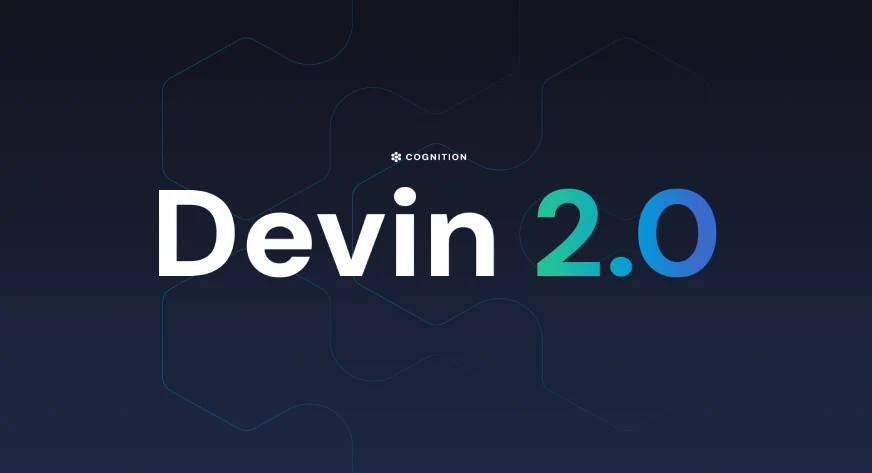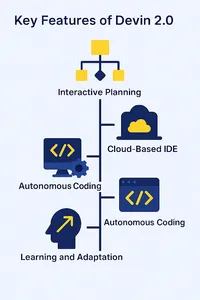ai tools are changing how developers work, and Devin 2.0 is part of that shift. Built by Cognition ai, it improves on the previous version in many ways. Devin 2.0 is faster, more efficient, and easier to use. It supports planning, coding, debugging, and task execution with simple prompts. Unlike the earlier version, it now features a cloud-based IDE where multiple agents can work in parallel. It also includes tools like Devin Wiki and Devin Search to better understand and document code. In this blog, we’ll explore its key features, how to use it, and how it compares to Windsurf and Cursor.
What is Devin 2.0?
Devin 2.0 is an advanced ai-powered software engineering tool developed by Cognition ai. Being the successor of Devin ai, known to be the world’s first “ai software engineer,” it is designed to assist developers by automating tasks like coding, debugging, testing, and deployment. It introduces several cutting-edge features aimed at improving productivity and collaboration, which we will explore further in this article.

Devin 2.0 Vs Devin 1.0: What’s new?
Before we explore the features of Devin 2.0, here’s how it compares to the original version:
<div class="table-responsive" style="overflow-x: auto;”>
Feature/Capability
Devin 1.0
Devin 2.0
Autonomous Coding
Yes; could write, test, and debug
Enhanced with better multi-step reasoning and deeper codebase analysis
Planning Capability
Basic task handling via prompts
Interactive Planning mode with clickable, editable roadmaps
Documentation
Limited or manual
Devin Wiki; automatic documentation + architecture diagrams
Parallel Agents
Not supported
Cloud IDE supports multiple Devins running in parallel
Code Search
Basic search
Devin Search; deep semantic search with citations
Adaptability
Static model behavior
Learns from past sessions; adapts to new tech and patterns over time
All in all, Devin 2.0 builds on the foundations of Devin 1.0 but expands it into a collaborative platform that goes beyond just being a coding assistant.
Key Features of Devin 2.0

- Interactive Planning: Devin can take vague project ideas and turn them into actionable plans, allowing developers to review and tweak them before execution.
- Cloud-Based IDE: The new agent-native IDE enables users to spin up multiple Devins simultaneously, each working on different tasks in parallel.
- Devin Search and Wiki: These tools allow users to query codebases for detailed answers with citations and auto-generate documentation, including architecture diagrams.
- Autonomous Coding: Devin can analyze entire codebases, identify issues, propose fixes, and even execute solutions without human input.
- Learning and Adaptation: It improves over time by learning from each project and adapting to new technologies or frameworks.
Also Read: Top 5 Code Editors to Vibe Code in 2025
How to Access Devin 2.0?
Time needed: 2 minutes
Here’s how you can access Devin 2.0:
- Visit the Official Website
Go to <a target="_blank" href="https://app.devin.ai/” target=”_blank” rel=”noreferrer noopener nofollow”>app.devin.ai to get started.
- Create an Account
Sign up for a Teams account by providing your email and necessary details.
- Early Access or Join the Waitlist (if required)
If Devin 2.0 is not yet publicly available, join the early access waitlist by filling out the form on the website. Provide your email, LinkedIn profile, and intended use case.
- Choose a Pricing Plan
Select the $20/month plan for 9 ACUs (Agent Compute Units) or explore pay-as-you-go options for additional usage.
- Access the Cloud-Based IDE
Log in to Devin’s cloud-based IDE to start using its features. You can deploy multiple ai agents to work on tasks simultaneously.
- Explore Devin’s Features
Use tools like Devin Search, Devin Wiki, and Interactive Planning to enhance your development workflow.
Putting Devin 2.0 to the Test
In this section, we’ll dive into a hands-on walkthrough of Devin 2.0 in action. From spinning up local environments to intelligent planning and real-time bug fixes, you’ll see how Devin performs on real-world engineering tasks.
Task 1: Cloud IDE & Parallel Execution in Action
Devin 2.0 is designed for parallelization, where each session runs in its own isolated virtual machine. This makes the cloud IDE the perfect interface for testing, reviewing, and modifying Devin’s work.
Key Highlights:
- Each task runs in an isolated VM without conflict between sessions.
- Devin can spin up applications locally using the integrated browser.
- View a compact change summary made by Devin.
- Modify code directly inside the IDE or use Cmd + I hotkey to:
<a target="_blank" href="https://x.com/cognition_labs/status/1907836723188695323″ target=”_blank” rel=”nofollow noopener”>Video Source
Task 2: Interactive Task Planning
When you initiate a new session, Devin automatically scans the codebase to understand the context relevant to your task.
Key Highlights:
- Devin starts with a preliminary answer containing:
- It enters planning mode, exploring deeper into the code to form a final plan.
- You get a plan overview with clickable code snippets.
- Once reviewed, hit the Confirm button to allow Devin to implement the changes.
<a target="_blank" href="https://x.com/cognition_labs/status/1907836727424856064″ target=”_blank” rel=”noreferrer noopener nofollow”>Video Source
Task 3: Codebase Search & Intelligent Issue Resolution
Devin Search lets you convert vague ideas into executable tasks using codebase intelligence.
Key Highlights:
- Issue: Some input boxes in a web app don’t handle Japanese input correctly.
- Ask Devin: “How do we handle Japanese input?”
- Devin suggests checking isComposing on input events.
- Then we trigger a deep search to:
- With Cmd + Enter, we generate a detailed task description for Devin.
- Devin then implements the fix automatically.
<a target="_blank" href="https://x.com/cognition_labs/status/1907836730822271111″ target=”_blank” rel=”nofollow noopener”>Video Source
Task 4: Devin Wiki – Instant Documentation for Your Codebase
Devin Wiki provides auto-generated explanations for every part of your codebase.
Key Highlights:
- Automatically generates documentation for your entire codebase.
- Includes textual explanations, diagrams, and links to relevant code.
- Continuously updates as the codebase evolves.
- Integrated with Devin Search—ask questions and get directed to the right Wiki page.
- Demoed on a Flask application to showcase its usefulness for real-world projects.
<a target="_blank" href="https://x.com/cognition_labs/status/1907836734475481182″ target=”_blank” rel=”nofollow noopener”>Video Source
Does Devin 2.0 Outshine Windsurf and Cursor?
Devin 2.0, Windsurf, and Cursor are all ai-powered coding assistants. However, they differ significantly in features, capabilities, and ultimately in target use cases. Here’s a comparison between Devin 2.0, Windsurf, and Cursor for a better understanding.
| Feature/Aspect | Devin 2.0 | Windsurf | Cursor |
| Core Focus | Autonomous coding agent with collaborative planning and documentation tools | Advanced project-aware IDE with automation for debugging, code generation, and iteration | ai-enhanced code editor focused on real-time collaboration and smart completion |
| Interactive Planning | Allows users to outline vague ideas; Devin refines them into actionable plans | Cascade ai Flow iteratively generates and runs code based on user approval | Limited to natural language commands for tasks; no detailed planning tools |
| Codebase Understanding | Devin Search for deep exploration of codebases with citations | Local Index engine retrieves context from the entire codebase | Semantic search across files, but less comprehensive than Devin or Windsurf |
| Documentation Support | Devin Wiki auto-generates wikis with architecture diagrams and source links | Memory system persists project rules and context across sessions | Basic documentation assistance; lacks automatic indexing or visualization |
| Automation Features | Can analyze codebases, identify issues, and propose fixes autonomously | Cascade automates debugging, testing, and iterative improvements | Agent mode automates tasks but requires manual confirmation for most actions |
| IDE Integration | Cloud-based IDE with support for multiple parallel Devins | Purpose-built IDE designed to streamline workflows | Built on Visual Studio Code with ai enhancements |
| Pricing Model | Starts at $20/month with pay-as-you-go options | Competitive pricing; exact details not specified | Free basic plan; Pro plan at $20/month |
| Unique Features | – Interactive Planning – Devin Wiki – Cloud-hosted multi-agent IDE |
– Cascade ai Flow – Image-to-code generation – Inline ai for precise edits |
– Semantic search – ai commit messages – Real-time collaboration |
Key Insights
- Devin 2.0 is tailored for teams needing autonomous planning, comprehensive documentation, and multi-agent support.
- Windsurf is ideal for iterative development with advanced automation features like Cascade ai Flow.
- Cursor ai is best suited for individual developers seeking a lightweight yet powerful ai assistant integrated into VS Code.
Also Read: Is Vibe Coding the Future? See What Top Leaders Have to
Do We Really Need Devin 2.0?
When Devin 1.0 was launched, it was a game changer: the first ai software engineer capable of coding, debugging, and deploying autonomously. However, the landscape has evolved rapidly since then. Today, tools like Windsurf and Cursor ai offer similar features, often available for free or at a lower price. As a result, it’s reasonable to question whether Devin 2.0 still holds a distinct advantage.
The answer depends on what you’re looking for. Devin 2.0 isn’t just a coding assistant; it’s a full-fledged platform that handles planning, execution, and documentation in one smooth workflow. Moreover, for teams tackling complex projects or enterprise-level systems where structure, efficiency, and scalability are essential, Devin 2.0 delivers a level of reliability and automation that is hard to surpass.
Conversely, if you’re an individual developer or part of a smaller team that is comfortable with customizing open-source tools or managing simpler workflows, options like Cursor ai or Windsurf might be more than enough.
So, is Devin 2.0 really needed? Not for everyone. But for those who value an all-in-one, autonomous system that can take projects from idea to deployment with minimal input, it might just be essential.
Conclusion
Devin 2.0 marks a significant leap in the evolution of ai-powered development tools. Although it may not be the best fit for every individual developer or small team, Devin 2.0 still stands out. Specifically, its robust features, such as autonomous task execution, intelligent planning, and real-time documentation, make it a compelling choice for teams managing complex, large-scale software projects.
By combining multiple essential tools into a single cohesive platform, Devin 2.0 redefines what it means to have an “ai software engineer” on your team. For organizations aiming to boost productivity, ensure consistency, and accelerate development cycles, Devin 2.0 could be the game-changing assistant they’ve been waiting for.
Frequently Asked Questions
A. Devin 2.0 is an advanced ai software engineer developed by Cognition ai. It automates coding, debugging, testing, and deployment tasks, while also offering features like Interactive Planning, Devin Search, and Devin Wiki to enhance productivity and collaboration.
A. Devin 2.0 introduces unique features such as a cloud-based IDE for running multiple agents in parallel, Interactive Planning for roadmap creation, and Devin Wiki for auto-generating detailed documentation and architecture diagrams. These features set it apart from free tools like Windsurf or Cursor.
A. Devin excels at repetitive engineering tasks like:
– Writing, testing, and deploying code
– Debugging and fixing bugs
– Refactoring code and migrating frameworks
– Generating documentation and architecture diagrams
– Improving test coverage and addressing CI failures
A. Devin 2.0 starts at $20/month for 9 ACUs (Agent Compute Units). Additional usage is billed on a pay-as-you-go basis, making it more affordable than its predecessor.
A. Yes! Devin is designed to work alongside human engineers by automating routine tasks while keeping developers informed and in control through its interactive IDE. It enhances collaboration by allowing users to refine plans, review work, and make adjustments as needed.
A. While powerful, Devin has some limitations:
– It performs better on smaller, clearly scoped tasks than large-scale challenges.
– It may require human intervention for UI aesthetics or mobile app testing.
– Users should exercise caution when sharing sensitive credentials.
A. You can sign up at <a target="_blank" href="https://app.devin.ai/” target=”_blank” rel=”noreferrer noopener nofollow”>app.devin.ai to create a Teams account. If your organization already uses Cognition ai tools, then you can request access through your administrator. Alternatively, reach out to Cognition’s sales team directly.
Login to continue reading and enjoy expert-curated content.
 NEWSLETTER
NEWSLETTER






